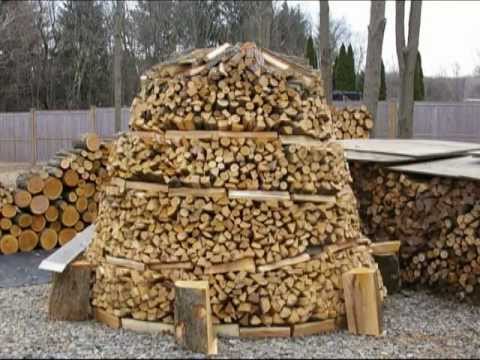Follow this method from Edward Zurmuhlen Chimney Sweep Extraordinaire. He is an Energy Conservation Specialist with the New York State Energy Office. His forte is renewable energy. He provides us with the following:
“Build a Holz Hausen” and go from living tree to seasoned firewood in as little as three months
During my years as a chimney sweep, the single largest waste of stored solar energy I observed was the use of seasoned wood to boil water out of green firewood (inside a stove) in order to get it to burn. Water in unseasoned firewood, like the water in a firefighter’s hose, does not burn!
In a living tree, nature provides a water-tight seal called bark to retain this moisture in the wood as the lifeblood of the tree. Seasoning of firewood begins in earnest when this seal is broken by splitting the wood. So, if a cordwood dealer is charging a premium price for seasoned firewood, ask the question. “When was it split?” before you spend your hardearned money to buy water.
Whether you harvest your own firewood or purchase it from a dealer, seasoning can be greatly accelerated by using the proper stacking method. I learned how to build a Holz Hausen (wood house) many years ago and had the opportunity to try it again this past summer when the utility company took down some trees on my street. Now after only three months in a Holz Hausen, my free firewood is burning nicely.
This age-old method of drying cordwood is a useful skill for any serious woodburner.
The dimensions of a traditional Hotz Hausen are a 10-foot-diameter circle with a center pole 10 feet high. However, I prefer a Holz Hausen with a 7-foot-diameter base, stacked to a more reachable height of 7 feet. Place a splash of paint or other dryness indicator at the 5 ft. 8 in. level. 80 percent of the 7-foot pole’s height.
5. Continue this stacking process until you have reached a height of about 5 feet. For the top 2 feet of stacking, don’t use any shims. This will allow the wood to begin to slope down toward the outside.
As the wood dries, it shrinks and the stack settles, losing 20 percent of its height. More and more of the pole is exposed above the top of the Holz Hausen. When you can see that patch of paint at 80 percent of the pole’s height, the wood is ready to burn.
Each advance in man’s ever increasing knowledge of how to keep warm, has made him more comfortable. However, the cost of this comfort has led a number of us to return to a more basic way of keeping warm.
Wood heat properly managed is environmentally benign because every molecule of carbon dioxide released by burning wood was taken from the atmosphere as the tree grew. Therefore, burning wood simply recyles carbon dioxide. Wood heat is a form of stored solar energy renewable within a man’s lifespan. Trees you plant in your lifetime can ensure that your grandchildren will be warm in their place.
**Note: The volume of a cylinder is Height x Pi x Radius squared. Applied to the traditional Holz Hausen, we have lO x 3.1415 x 25, or 785 cubic feet of wood. A standard cord is 4 x 4 x 8 = 128 cu. ft., so the traditional 10-foot high Holz Hausen contains about six cords of wood, enough for most German winters. The 7-foot version will have volume of approximately 269 cu. ft., or two full cords of wood.
*Edward J. Zurmuhlen, AKA “Otto Best, C. S. E.” Chimney Sweep Extraordinaire he lives in Ballston Spa, New York.
Thanks to The Chimney Sweep for allowing us to reproduce this.
